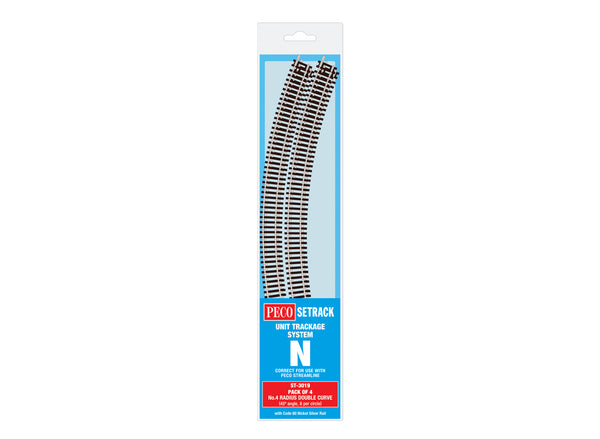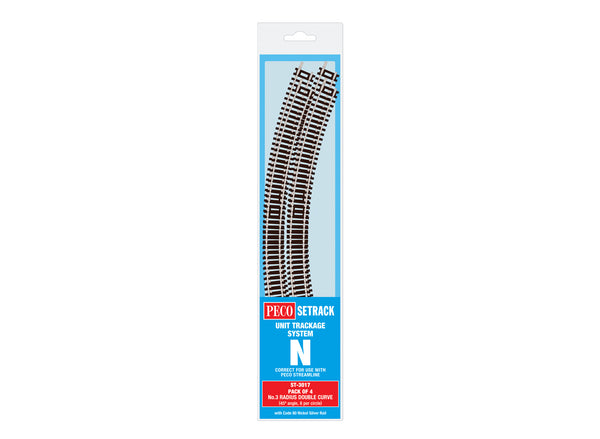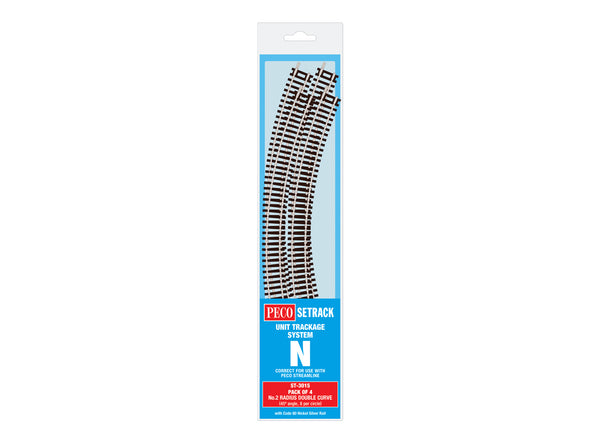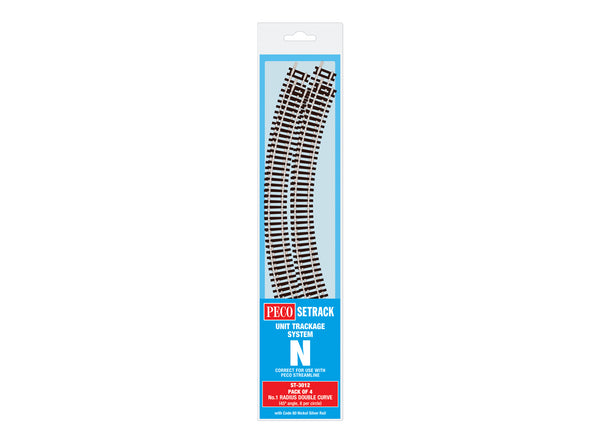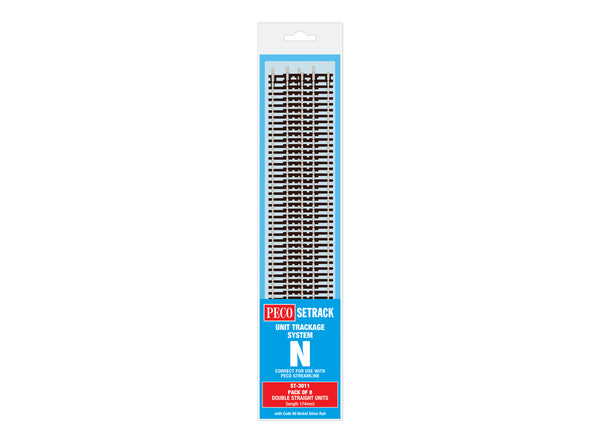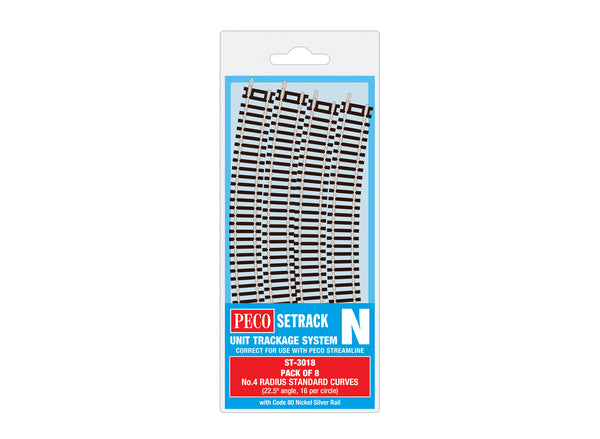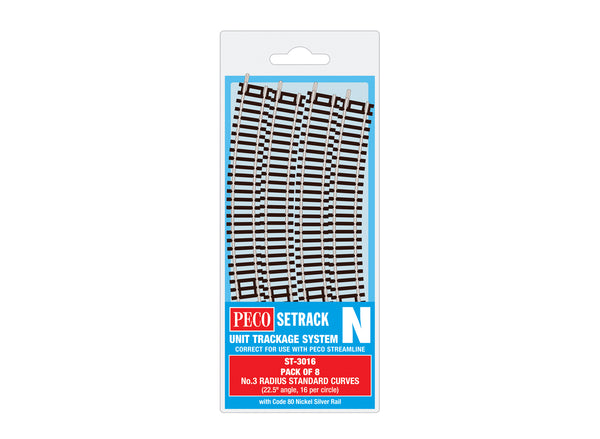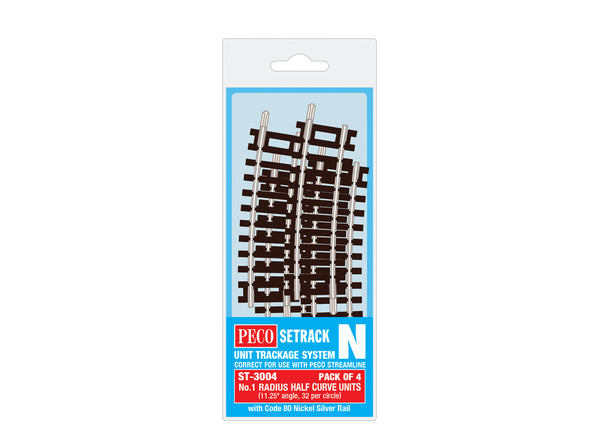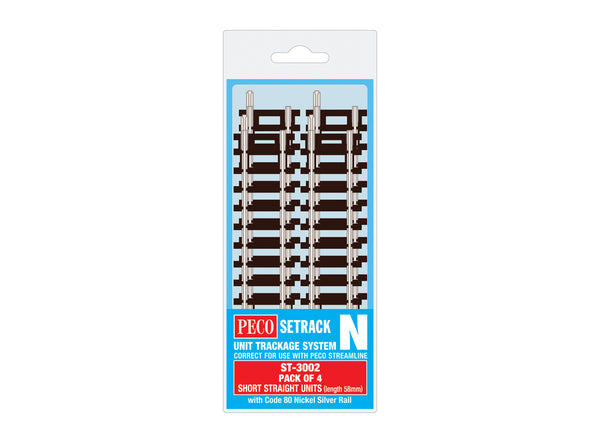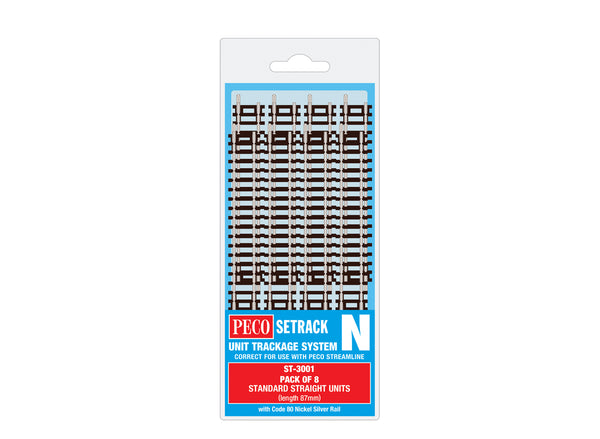BROWSE PECO PRODUCTS
Browse through our complete product portfolio.
1201 Products Found
Double Curve, 4th Radius (Pack of 4)
This pack will make a semi-circle of track.
PECO Setrack N Gauge Code 80 - Unit trackage System
The high quality rigid unit trackage system suitable for all popular brands of N gauge model trains.
Being fully compatible with both Code 80 and Code 55 PECO Streamline, it need never be discarded as your layout develops.
The solid nickel silver rails are integrally moulded into the sleeper bases for maximum realism and strength. Turnouts are fitted with an over-centre spring for immediate use, no extra levers necessary.
Double Curve, 3rd Radius (Pack of 4)
This pack will make a semi-circle of track.
PECO Setrack N Gauge Code 80 - Unit trackage System
The high quality rigid unit trackage system suitable for all popular brands of N gauge model trains.
Being fully compatible with both Code 80 and Code 55 PECO Streamline, it need never be discarded as your layout develops.
The solid nickel silver rails are integrally moulded into the sleeper bases for maximum realism and strength. Turnouts are fitted with an over-centre spring for immediate use, no extra levers necessary.
Double Curve, 2nd Radius (Pack of 4)
This pack will make a semi-circle of track.
PECO Setrack N Gauge Code 80 - Unit trackage System
The high quality rigid unit trackage system suitable for all popular brands of N gauge model trains.
Being fully compatible with both Code 80 and Code 55 PECO Streamline, it need never be discarded as your layout develops.
The solid nickel silver rails are integrally moulded into the sleeper bases for maximum realism and strength. Turnouts are fitted with an over-centre spring for immediate use, no extra levers necessary.
Double Curve, 1st Radius (Pack of 4)
This pack will make a semi-circle of track.
PECO Setrack N Gauge Code 80 - Unit trackage System
The high quality rigid unit trackage system suitable for all popular brands of N gauge model trains.
Being fully compatible with both Code 80 and Code 55 PECO Streamline, it need never be discarded as your layout develops.
The solid nickel silver rails are integrally moulded into the sleeper bases for maximum realism and strength. Turnouts are fitted with an over-centre spring for immediate use, no extra levers necessary.
Double Straight (Pack of 8)
PECO Setrack N Gauge Code 80 - Unit trackage System
The high quality rigid unit trackage system suitable for all popular brands of N gauge model trains.
Being fully compatible with both Code 80 and Code 55 PECO Streamline, it need never be discarded as your layout develops.
The solid nickel silver rails are integrally moulded into the sleeper bases for maximum realism and strength. Turnouts are fitted with an over-centre spring for immediate use, no extra levers necessary.
Standard Curve, 4th Radius (Pack of 8)
This pack will make a semi-circle of track.
PECO Setrack N Gauge Code 80 - Unit trackage System
The high quality rigid unit trackage system suitable for all popular brands of N gauge model trains.
Being fully compatible with both Code 80 and Code 55 PECO Streamline, it need never be discarded as your layout develops.
The solid nickel silver rails are integrally moulded into the sleeper bases for maximum realism and strength. Turnouts are fitted with an over-centre spring for immediate use, no extra levers necessary.
Standard Curve, 3rd Radius (Pack of 8)
This pack will make a semi-circle of track.
PECO Setrack N Gauge Code 80 - Unit trackage System
The high quality rigid unit trackage system suitable for all popular brands of N gauge model trains.
Being fully compatible with both Code 80 and Code 55 PECO Streamline, it need never be discarded as your layout develops.
The solid nickel silver rails are integrally moulded into the sleeper bases for maximum realism and strength. Turnouts are fitted with an over-centre spring for immediate use, no extra levers necessary.
Standard Curve, 2nd Radius (Pack of 8)
This pack will make a semi-circle of track.
PECO Setrack N Gauge Code 80 - Unit trackage System
The high quality rigid unit trackage system suitable for all popular brands of N gauge model trains.
Being fully compatible with both Code 80 and Code 55 PECO Streamline, it need never be discarded as your layout develops.
The solid nickel silver rails are integrally moulded into the sleeper bases for maximum realism and strength. Turnouts are fitted with an over-centre spring for immediate use, no extra levers necessary.
Half Curve, 1st Radius (Pack of 4)
PECO Setrack N Gauge Code 80 - Unit trackage System
The high quality rigid unit trackage system suitable for all popular brands of N gauge model trains.
Being fully compatible with both Code 80 and Code 55 PECO Streamline, it need never be discarded as your layout develops.
The solid nickel silver rails are integrally moulded into the sleeper bases for maximum realism and strength. Turnouts are fitted with an over-centre spring for immediate use, no extra levers necessary.
Standard Curve, 1st Radius (Pack of 8)
This pack will make a semi-circle of track.
PECO Setrack N Gauge Code 80 - Unit trackage System
The high quality rigid unit trackage system suitable for all popular brands of N gauge model trains.
Being fully compatible with both Code 80 and Code 55 PECO Streamline, it need never be discarded as your layout develops.
The solid nickel silver rails are integrally moulded into the sleeper bases for maximum realism and strength. Turnouts are fitted with an over-centre spring for immediate use, no extra levers necessary.
Short Straight (Pack of 4)
PECO Setrack N Gauge Code 80 - Unit trackage System
The high quality rigid unit trackage system suitable for all popular brands of N gauge model trains.
Being fully compatible with both Code 80 and Code 55 PECO Streamline, it need never be discarded as your layout develops.
The solid nickel silver rails are integrally moulded into the sleeper bases for maximum realism and strength. Turnouts are fitted with an over-centre spring for immediate use, no extra levers necessary.
Standard Straight (Pack of 8)
PECO Setrack N Gauge Code 80 - Unit trackage System
The high quality rigid unit trackage system suitable for all popular brands of N gauge model trains.
Being fully compatible with both Code 80 and Code 55 PECO Streamline, it need never be discarded as your layout develops.
The solid nickel silver rails are integrally moulded into the sleeper bases for maximum realism and strength. Turnouts are fitted with an over-centre spring for immediate use, no extra levers necessary.










